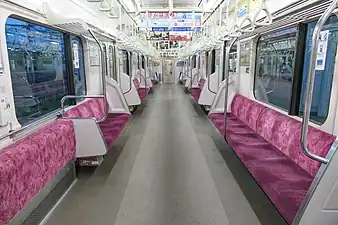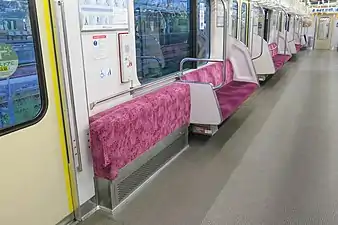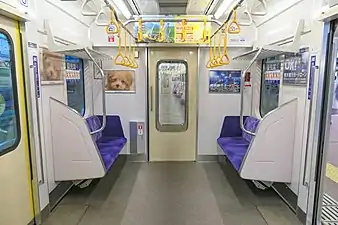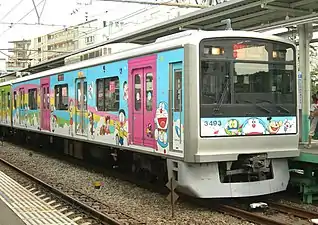| Odakyu 3000 series | |
|---|---|
 10-car set 3081 in November 2021 | |
| Manufacturer | Kawasaki Heavy Industries, Nippon Sharyo, Tokyu Car Corporation |
| Constructed | 2001– |
| Entered service | 10 February 2002 |
| Number built | 336 vehicles (47 sets) (as of January 2019) |
| Number in service | 336 vehicles (47 sets) (as of January 2019) |
| Formation | 6/8/10-car sets |
| Operators | Odakyu Electric Railway |
| Depots | Ebina |
| Specifications | |
| Car body construction | Stainless steel |
| Car length | 20,000 mm (65 ft 7 in) |
| Doors | 4 pairs per side |
| Maximum speed | 100 km/h (62 mph) |
| Traction system | Variable frequency (IGBT) |
| Acceleration | 3.3 km/(h⋅s) (2.1 mph/s) |
| Electric system(s) | 1,500 V DC overhead lines |
| Current collector(s) | Pantograph |
| Safety system(s) | OM-ATS |
| Multiple working | Odakyu 8000 series |
| Track gauge | 1,067 mm (3 ft 6 in) |
The Odakyu 3000 series (小田急3000形, Odakyū 3000-gata) is an electric multiple unit (EMU) commuter train type operated by the private railway operator Odakyu Electric Railway in Japan. First introduced on 10 February 2002, a total of 336 cars were built with orders divided between Nippon Sharyo, Tokyu Car Corporation, and Kawasaki Heavy Industries. Originally formed as six- and eight-car trainsets, additional cars have been built since 2010 to augment pre-existing sets to ten cars.
Formations
10-car sets
The 10-car sets, numbered 3081 to 3095, are formed as follows.
| Designation | Tc1 | M1 | M2 | T1 | T2 | M3 | M4 | T3 | M5 | Tc2 |
|---|---|---|---|---|---|---|---|---|---|---|
| Numbering | 3050 | 3000 | 3100 | 3150 | 3250 | 3200 | 3300 | 3350 | 3400 | 3450 |
The M1, T1, M3, and M5 cars each have one single-arm pantograph.[1]
8-car sets 3651–3665
| Designation | Tc1 | M1 | M2 | T1 | T2 | M3 | M4 | Tc2 |
|---|---|---|---|---|---|---|---|---|
| Numbering | 3650 | 3600 | 3700 | 3750 | 3850 | 3800 | 3900 | 3950 |
The M1, T1, and M3 cars each have one single-arm pantograph.[2]
6-car sets 3251–3262
| Designation | Tc1 | M1 | M2 | M3 | M4 | Tc2 |
|---|---|---|---|---|---|---|
| Numbering | 3250 | 3200 | 3300 | 3400 | 3500 | 3550 |
The M1 and M3 cars each have one single-arm pantograph. Sets 3252 to 3254 have wider doors.[2]
6-car sets 3263–3282
| Designation | Tc1 | M1 | M2 | T | M3 | Tc2 |
|---|---|---|---|---|---|---|
| Numbering | 3250 | 3200 | 3300 | 3350 | 3400 | 3450 |
The M1 and M3 cars each have one single-arm pantograph.[2]
Interior
Passenger accommodation consists of longitudinal bench seating throughout.
 Interior
Interior Folding seat
Folding seat Priority seat
Priority seat
Operational history
The 3000 series entered service on 10 February 2002.[3]: 21
10-car set introduction
In 2010, Odakyu announced plans to procure eight cars to extend six-car sets to 10-car sets.[4] These cars were delivered between 2010 and 2011 from Kawasaki Heavy Industries' Hyogo plant[5] and used to augment six-car sets 3280 and 3281 to 10 cars; the sets were renumbered 3091 and 3092, respectively.[1] The first 10-car set, 3091, entered service on 20 January 2011.[6]
As of January 2019, five additional 10-car sets have since been introduced: 3081, 3082 (formerly eight-car sets 3665 and 3664, respectively), and 3093–3095 (formerly six-car sets 3282, 3278, and 3279, respectively[7]).[8][9]
Livery variations
Doraemon-liveried "F-Train"
In August 2011, 10-car set 3093 was reliveried in a Doraemon livery to commemorate the opening of the Fujiko F. Fujio Museum in Kawasaki, Kanagawa. The train was scheduled to run in its livery for one year, but this was cut short due to complaints from the Tokyo Metropolitan Government that it violated metropolitan ordinances regulating advertising on train exteriors. The decorated "F-Train" remained in service until 30 September 2011, before the exterior advertising was removed.[10]
 Set 3093 in Doraemon livery in September 2011
Set 3093 in Doraemon livery in September 2011
References
- 1 2 小田急電鉄3000形 中間車製造と10両固定編成化 [Odakyu 3000 series - New intermediate car production and lengthening to 10-car sets]. Japan Railfan Magazine. Vol. 51, no. 602. Japan: Kōyūsha Co., Ltd. 2011. pp. 72–75.
- 1 2 3 私鉄車両編成表 2010 [Private Railway Rolling Stock Formations - 2010]. Japan: JRR. August 2010. p. 47. ISBN 978-4-330-15310-0.
- ↑ 大手私鉄の最新通勤形電車 [The newest commuter trains of the private railways]. Japan Railfan Magazine (in Japanese). Vol. 42, no. 497. Koyusha Co., Ltd. September 2002. pp. 9–45.
- ↑ 小田急3000形10輌固定編成 試運転 [Odakyu 3000 series test run as 10-car set]. Tetsudo Hobidas (in Japanese). Neko Publishing. 7 January 2011. Archived from the original on 10 January 2011. Retrieved 8 January 2011.
- ↑ 大手私鉄の車両ファイル 車両データバンク [Major Private Railway Vehicle File - DATA BANK]. Japan Railfan Magazine (in Japanese). Vol. 51, no. 605. Japan: Koyusha Co., Ltd. September 2011.
- ↑ 10両固定編成の小田急3000形が営業運転を開始 [Odakyu 3000 series 10-car set begins commercial operation]. Japan Railfan Magazine Online (in Japanese). Japan: Koyusha Co., Ltd. 30 January 2011. Archived from the original on 18 May 2022. Retrieved 8 June 2022.
- ↑ 大手私鉄の車両ファイル 車両データバンク [Major Private Railway Vehicle File - DATA BANK]. Japan Railfan Magazine (in Japanese). Vol. 52, no. 616. Japan: Koyusha Co., Ltd. August 2012.
- ↑ 小田急3000形3081編成が試運転を実施 [Odakyu 3000 series set 3081 on test]. Japan Railfan Magazine Online (in Japanese). Japan: Koyusha Co., Ltd. 19 December 2017. Archived from the original on 13 February 2018. Retrieved 8 April 2023.
- ↑ 小田急3000形3082編成が営業運転を開始 [Odakyu 3000 series set 3082 enters revenue service]. Japan Railfan Magazine Online (in Japanese). Japan: Koyusha Co., Ltd. 12 January 2019. Archived from the original on 6 March 2021. Retrieved 8 April 2023.
- ↑ "Ad rule means end of Doraemon train". Daily Yomiuri Online. Japan: The Yomiuri Shimbun. 24 September 2011. Archived from the original on 18 February 2013. Retrieved 2 February 2012.
